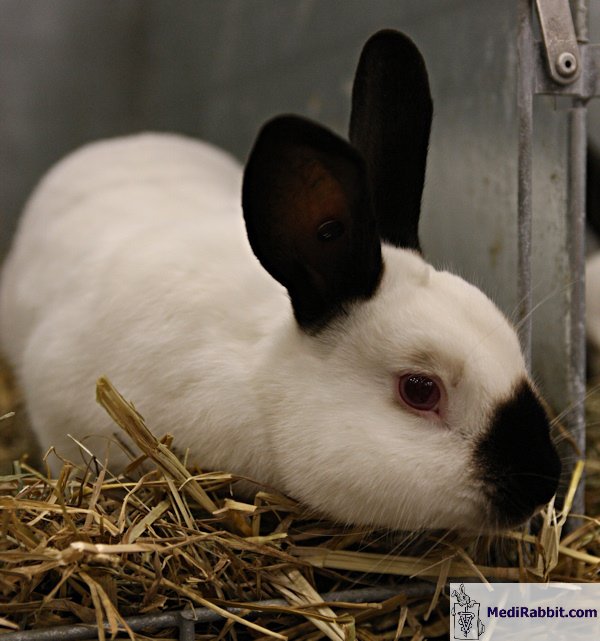How to
obtain a white rabbit with red eyes that is
not an
albinos ?
Michel Gruaz
MediRabbit.com is funded solely by the
generosity of donors.
Every donation, no matter what
the size, is appreciated and will aid in the continuing research of medical care
and health of rabbits all over the world.
Thank you
|
This is what our rabbit experts
learned, after the excellent introduction of a study of heredity given by Mr.
Urban Hamann. This member of the technical
commission is passionate about rabbit genetics.
The first part of
the course consisted of a general rehearsal of the principles of heredity.
Mr. Hamann recalled the terms used in this field
and their meaning. As far as the experts are concerned, it is eminently
desirable for them to be able to answer questions raised by breeders and to
tell them what can be expected when mating pure-breed seal rabbits or spotted
rabbits or that mating a white Vienna rabbit with a white New Zealand female
will lead to offspring with colored fur.
Transmission
of characters from parents to offspring
Heredity enables
the conservation of the species, but also of a breed and a breeding lineage.
It includes the visible inherited characteristics such as the external
appearance (phenotype), but also all the hidden particularities, thus
recessive, which will lead to qualities and/or defects in future generations. Luckily, breeders
work with noble and natural hereditary “material”; they are in no way concerned
by genetic manipulations that we all too often hear about. Because they do
not wish to take any chance, they are open and prepared to be confronted with
genetics. After the complex process of multiplication, followed by the
division of the cells called meiosis, 22 chromosomes and their many enclosed
genes come equally from each of the two parents. Offspring should, therefore,
be all the same if there would not be a big genetic mix that ensures that no
animal has exactly the same genotype. Identical twins only, from the same egg
or zygote, have the same genetic heritage. Lineage breeding does, however,
reduce the possibility of fluctuations, both of the phenotype and the
genotype, and tends towards purity of characters and uniformity of subjects. The
breeding qualities of a rabbit are judged on the basis of the level of the
family, lineage and strain. Also, experienced breeders will more likely buy a
rabbit that has obtained 95 points, from a breeder whose other animals also
present good qualities, rather than a 96-point rabbit that comes from a
poorly stabilized and irregular breeding program.
The male
in mammals but the female in oviparous
In mammals it is
the male that determines the sex of the offspring. This is because his sexual
chromosomes consist of an X and a Y. He has, therefore, a divided heredity,
while the female XX has a net hereditary. She can only give birth to females.
In birds, for example, the opposite is true. In birds, as for tricolor cats,
the colors of the male and the female are very different; the genes that
determine the color of the feathers are on the X chromosome. In theory,
according to the principles of heredity, the number of males and females is
almost identical. The same is true of the pattern of transmission of inherited
diseases such as long teeth, eye abnormalities or any abnormalities of the
genitals, for example.
The
peculiarity of rabbits with yellow-colored fat
It is important to
know that siblings may sometimes have fewer similar hereditary dispositions
than distant relatives. However, when two parents are not already related,
the rate of uniformity of the offspring is usually 50%. Hamann
recalled the phenomenon by which the colors appeared and explained that a
subject with yellow or red colored fur might show different shades according
to the lighting of that moment. He pointed out that the rabbits cannot store
carotene in their fur, contrary to an old belief among breeders. The
distribution of colored foods, such as carrots or red beets, does therefore
not affect the fur color of rabbits. In rare cases, a genetic anomaly in
rabbits belonging to several breeds leads to the accumulation of yellow
pigments present in the eaten food distributed in their fat. The latter
becomes more and more yellow when the rabbit growth older.
How to
obtain a white rabbit with non-albino red eyes
Even if there is
not a real interest in obtaining such an animal, the theory clearly
demonstrates that using pure-breed rabbits and, knowing the laws of heredity,
this bet is achievable. Who would have thought that two breeding options
would lead to the same little crazy goal ? By
combining the Russian factor with the leucist
factor by mating a Dwarf with the Russian fur characteristics with a white
Dwarf with blue eyes, the F1 offspring will all have a solid colored fur with
a loss of the characteristics of the two initial Russian and leucism factors.
By mating F1
subjects with each other, the science of heredity confirms that 1/16 of
the descendants will be white with red-colored eyes, without being albino. To
have a formal proof, we will proceed to a subsequent mating with a Hermelin rabbit, which will result in only colorful
descendants. The second option is to combine the chinchilla factor with the
"lutino" factor, a characteristic of Danish breeding, which allows to obtain rabbits with a yellowish fur with red eyes, as
those of albino rabbits. In the F2 generation, 1/16 of the rabbits will be
white with red eyes, which are not albino.
As the proportion is of only one sixteenth, success may not be
obtained with the first litter already.
|
e-mail: info@medirabbit.com







